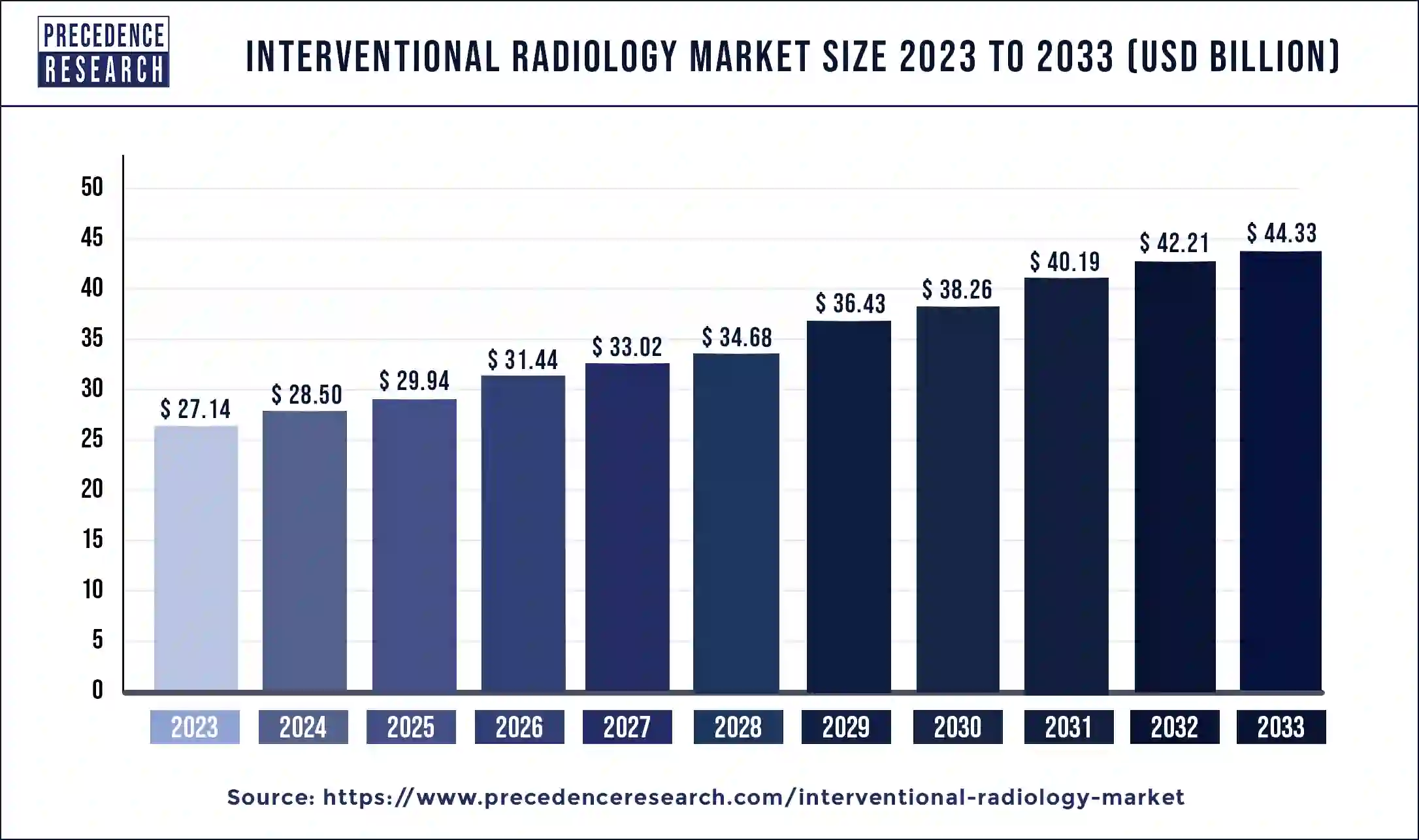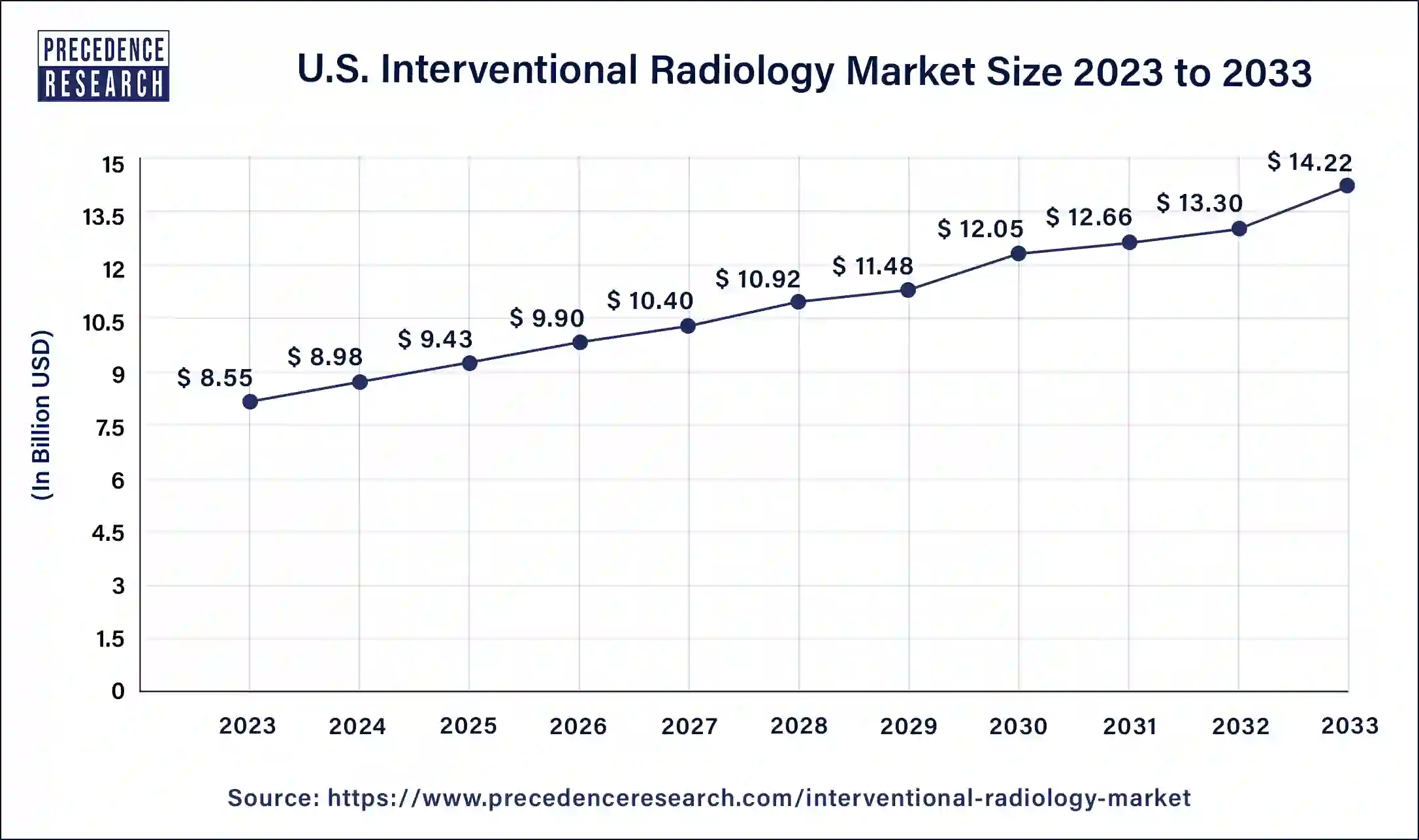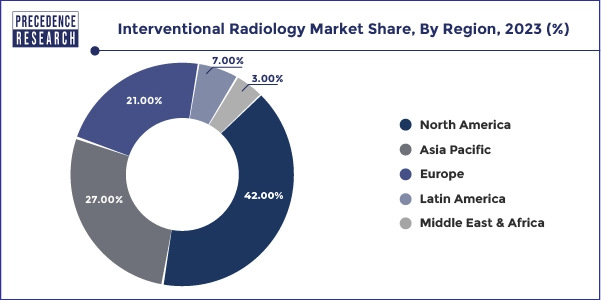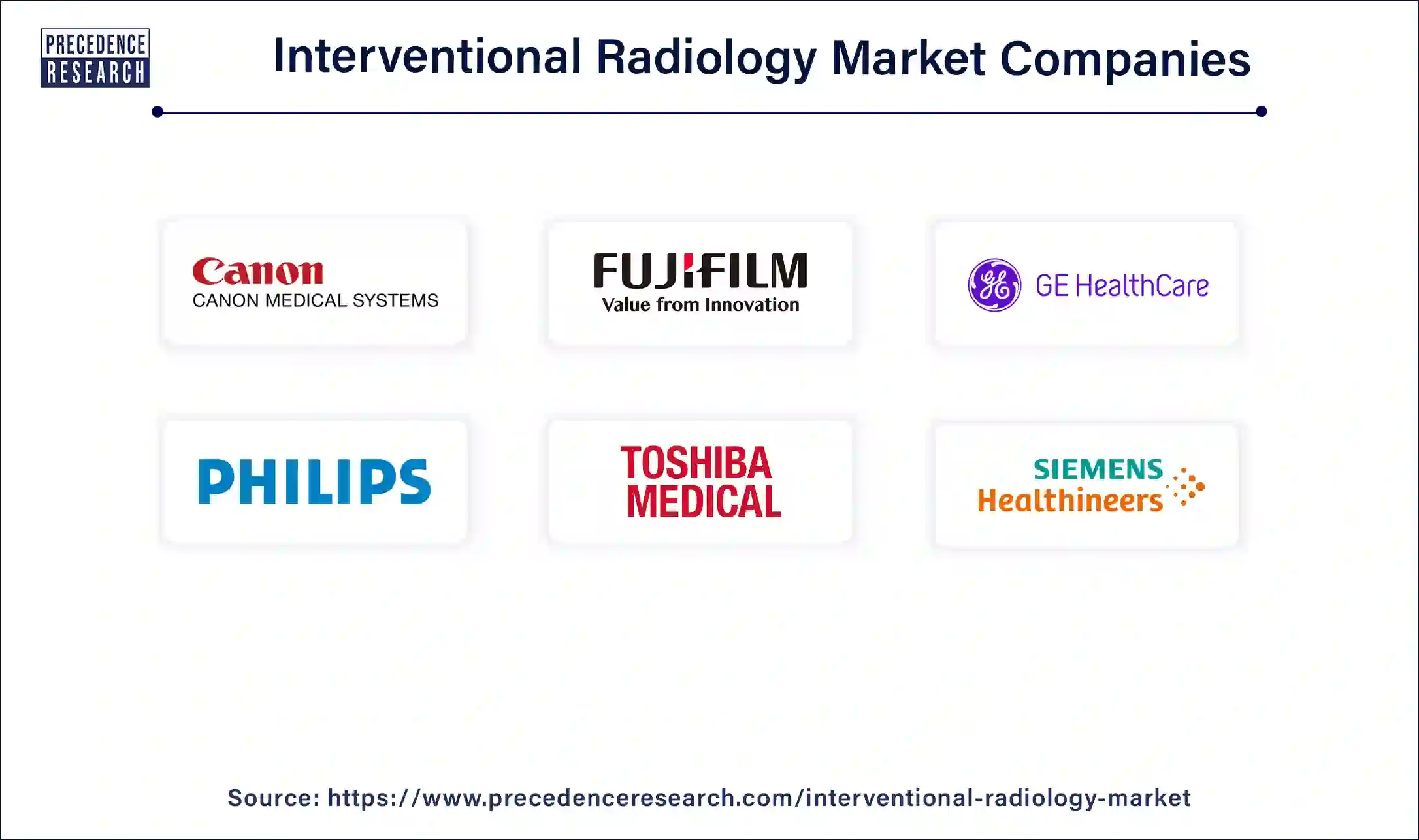January 2025
Interventional Radiology Market (By Product: Ultrasound imaging systems, MRI systems, CT scanners, Angiography systems; By Application: Oncology, Cardiology, Urology, Gastroenterology, Gynecology, Obstetrics) - Global Industry Analysis, Size, Share, Growth, Trends, Regional Outlook, and Forecast 2024-2033
The global interventional radiology market size was valued at USD 27.14 billion in 2023 and is anticipated to reach around USD 44.33 billion by 2033, growing at a CAGR of 5.03% from 2024 to 2033. The rising prevalence of chronic illness among the population drives the growth of the market.

The U.S. interventional radiology market size was estimated at USD 8.55 billion in 2023 and is predicted to be worth around USD 14.22 billion by 2033, at a CAGR of 5.21% from 2024 to 2033.

North America led the interventional radiology market with the largest market share in 2023. The growth of the market in the region is increasing due to the higher number of chronic diseases such as cancer due to the unhealthy lifestyle that drives the demand for the market. The rising healthcare infrastructure and the technological adoption in the treatment of most chronic diseases have expanded the demand for the interventional radiology market. The rising participation and the presence of the major healthcare and pharmaceutical facilities in the region are contributing to the growth of the market. Additionally, investments in research and development activities in the expansion of the technologies that drives the growth of the market in the region.
Asia Pacific is estimated to grow at the fastest rate during the forecast period. Asia and Europe are among the top regions that face the highest levels of deaths associated with CVDs. When it comes to diabetes, which uses radiology to diagnose complications associated with diabetes, China (174.4 million patients till 2045) has the highest number of diabetic patients, followed by India (124.9 million patients till 2045) and Pakistan (62.2 million patients till 2045). The countries are going to rank in the top three until 2045.

According to research published in September 2023 in Radiation Medicine and Protection Journal, in the past 20 years, the radiology equipment per million population in China has increased significantly. Dental radiology equipment has increased ninefold, followed by CT scanners with a fivefold increase.
Europe also has a significant share of the interventional radiology market. The growth of the market is expected to increase due to the rising healthcare infrastructure and the improvement in the development of technological evolution in modern devices and equipment, driven by the rising number of geriatric patients who are more prone to chronic illness. Thus, all these factors contribute to the expansion of the interventional radiology market in the region.
Interventional Radiology Market Overview
Interventional radiology is a specialized field of radiology procedures. Physicians use interventional radiology for imaging to guide the minimally invasive surgical procedures for the treatment, diagnosis, and detection of several chronic diseases. Interventional radiology is highly efficient in treatment, cost, and pain relieving, reduces recovery time, and reduces the risk of the patients by traditional open surgery. Interventional radiology includes imaging techniques like MRI scanners, CT scanners, angiography systems, and ultrasound, which are widely used in procedures. The rising prevalence of chronic illness and the demand for effective treatment procedures drive the expansion of the interventional radiology market.
| Report Coverage | Details |
| Interventional Radiology Market Size in 2023 | USD 27.14 Billion |
| Interventional Radiology Market Size in 2024 | USD 28.50 Billion |
| Interventional Radiology Market Size by 2033 | USD 27.14 Billion |
| Interventional Radiology Market Growth Rate | CAGR of 5.03% from 2024 to 2033 |
| Largest Market | North America |
| Base Year | 2023 |
| Forecast Period | 2024 to 2033 |
| Segments Covered | Product, Application, and Regions |
| Regions Covered | North America, Europe, Asia-Pacific, Latin America, and Middle East & Africa |
Driver: Rising prevalence of chronic diseases
The rising global population, geriatric population, rising healthcare infrastructure, and the prevalence of chronic diseases such as cancer, cardiovascular diseases, and other severe diseases demand early detection and diagnosis with minimally invasive treatment that drives the demand for the interventional radiology market. The rising number of cancer diseases globally is positively influencing the demand for interventional radiology. It helps in the treatment of cancer in several ways. It directly treats the disease by preventing bleeding during surgeries, providing pain relief, and reducing the side effects of cancer treatment. Interventional radiology is directly used in cancer cells and in cancer-killing therapies like chemotherapy and radioactive medicine in tumors and cancer cells. Thus, the rising cases of cancer and the demand for effective and minimal treatment procedures have contributed to the growth of the interventional radiology market.
Restraint: High cost
The increased cost associated with the products due to the integration of smart technologies is limiting the expansion of the interventional radiology market. The high cost of radiology is due to various reasons, including the use of advanced systems like CT and MRI machines. Radiology reading services, insurer reimbursement rules, healthcare system costs, and the type of patient care determine the further costs associated with interventional radiology. Cost reduction from the hospital end can be done by purchasing alternative equipment at low prices, purchasing in bulk, reducing the use of films, and altering the patterns of some supplies. This will help in reducing the charges applied to patients.
Opportunity: Technological advancements
The evaluation of the technologies associated with the healthcare industry and the increasing adoption of the technologies for detection and diagnosis with minimal treatment drive the expansion of the market. Technological innovations in interventional radiology include multimodality image fusion guided procedures, cone-beam computed tomography (CBCT), and preoperative imaging to improve the efficiency of the procedures. The rising investment in the technologies of interventional radiology by the major market players and the rising participation of new start-ups for technological evaluation drive the growth of the interventional radiology market. The integration of technologies such as augmented reality and virtual reality in the treatment is further propelling the growth of the market in the forecast period.
The ultrasound imaging systems segment dominated the market with the highest market growth in 2023. The rising adoption of ultrasound interventional radiology by major healthcare facilities for the treatment and detection of several diseases is driving the demand for ultrasound imaging systems. The ultrasound imaging system is one of the important parts in the interventional radiology procedures. The ultrasound imaging system includes procedures like thoracentesis (fluid drainage around the lungs), drainage of Baker’s cysts and abscesses, paracentesis (fluid drainage from the abdominal cavity), and the placement of PICC lines. It is also used in procedures like hysterosonography and amniocentesis. Ultrasound imaging system is a cost-effective alternative to MRI magnetic resonance imaging with accurate guidance. It does not involve radiation exposure, which is safer for patients. Thus, all these properties are propelling the demand for the ultrasound imaging system.
The cardiology segment dominated the interventional radiology market in 2023. Cardiovascular diseases (CVDs) are the most common diseases that occur, and they are responsible for the highest number of deaths. Physical inactivity, tobacco consumption, alcohol consumption, unhealthy diet, occupational hazards, and pollution are the major causes of CVDs. Heart diseases, heart attacks, heart failure, arrhythmia, stroke, and heart valve problems are all CVDs that need radiology for monitoring.
The oncology segment is estimated to grow at the fastest CAGR during the forecast period. The rising prevalence of cancer globally drives the demand for oncology interventional radiology treatment. Interventional radiology in cancer treatment is also known as interventional oncology. In interventional oncology, the radiologist uses imaging like computed tomography (CT), fluoroscopy, and ultrasound to deliver cancer therapies directly to the cancer cells or tumors that are leaving the healthy, untouched tissues. Interventional oncology involved no anesthesia, faster recovery, and minimal discomfort. Oncology intervention is a treatment with higher efficiency that can kill cancer tumors, relieve the pain of the treatment, and extend the life of the patients. Thus, the higher prevalence of cancer globally drives the demand for the interventional oncology segment.

Segments Covered in the Report
By Product
By Application
By Geography
For inquiries regarding discounts, bulk purchases, or customization requests, please contact us at sales@precedenceresearch.com
No cookie-cutter, only authentic analysis – take the 1st step to become a Precedence Research client
January 2025
July 2024